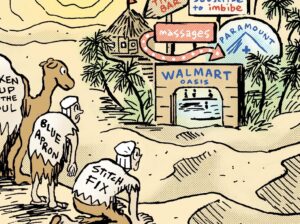The IAB released its first set of standards for retail media at the beginning of December. But are these new standards the Christmas gift advertisers have been waiting for?
Not exactly.
Brands want standards to make it easier to spend across multiple retail media networks. Absent standardization, it makes sense for brands to spend their budgets with the largest incumbents.
But with standardization, marketers can more easily spend across different platforms, which gives smaller players a leg up. Standards could be a boon for mid-tier retail media networks like Kevel and CitrusAd.
However, the IAB’s new standards are narrowly focused on defining in-store media types. For example, they establish metrics for ad impressions in brick-and-mortar locations, such as “opportunity to see” an ad (OTS) and its slightly more precise cousin, “likelihood to see” (LTS). Just what the industry needs: a new slate of three-letter acronyms.
All IAB standards are essentially voluntary. It’s up to the industry to adopt them or not. As AdExchanger Senior Editor James Hercher explains, while no retail media network is likely to oppose standardization, some of the biggest players, like Criteo and Walmart, will probably not be inclined to push forcefully for their adoption.
AI in advertising
We close out 2024 with everyone’s favorite topic: the rise of generative AI in advertising. Associate Editor Victoria McNally asked her sources for their take on AI. How will marketers evolve their use of the tech in the coming year? And if you’re expecting responses that buy into the usual hype, prepare to be surprised.
Forget ChatGPT – marketers are sick of the AI conversation revolving around chatbots.
Similarly, don’t expect every agency to embrace AI-generated ads that have been automatically tailored to the individual user. That stuff isn’t ready for prime time, and there’s no way to tell if that degree of AI-powered ad personalization will ever be cost-effective – or effective at all from a performance standpoint.
Instead of diving into AI head first, many marketers are dipping their toes, testing lower-impact applications like AI-generated subject lines for email blasts.
Still, marketers are trusting AI more each year, according to numbers from Advertiser Perceptions. In 2023, just one in four advertisers said they trust AI to make campaign decisions without human oversight. But this year, half of advertisers said they trust AI without human supervision.
We discuss the implications of that growing trust. Is it based on a sound understanding of the tech behind trendy AI tools, or are platforms selling a bill of goods?

















